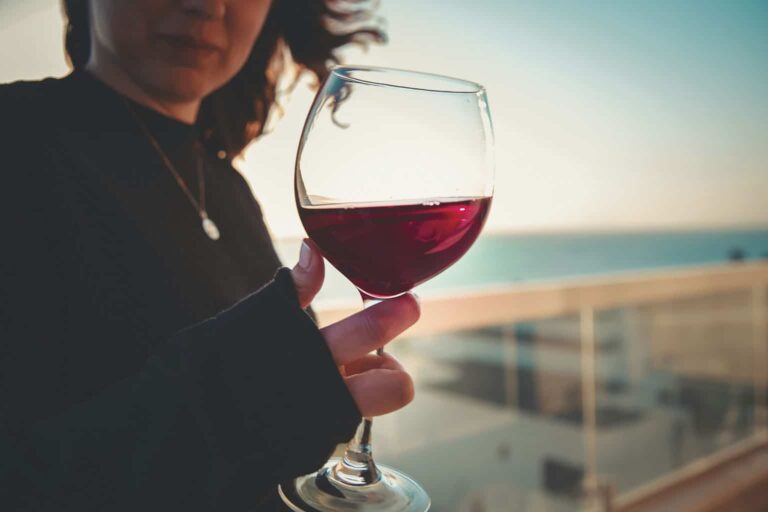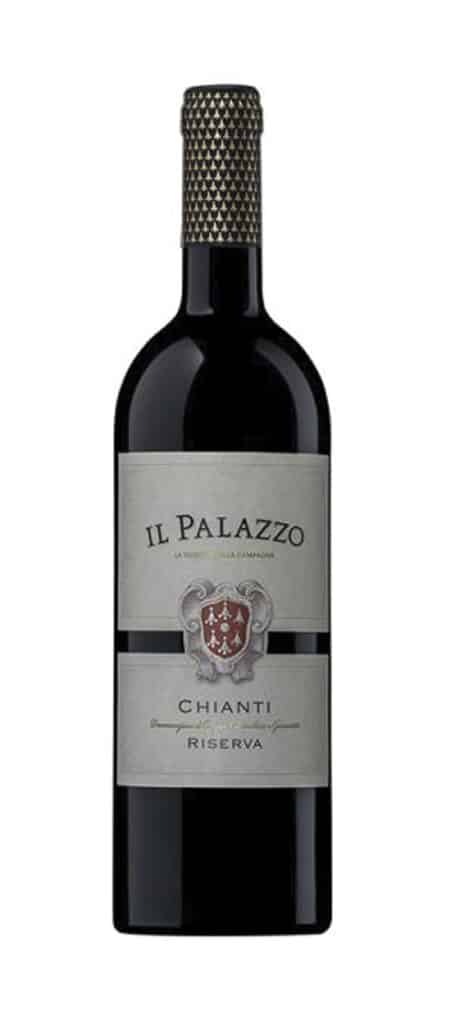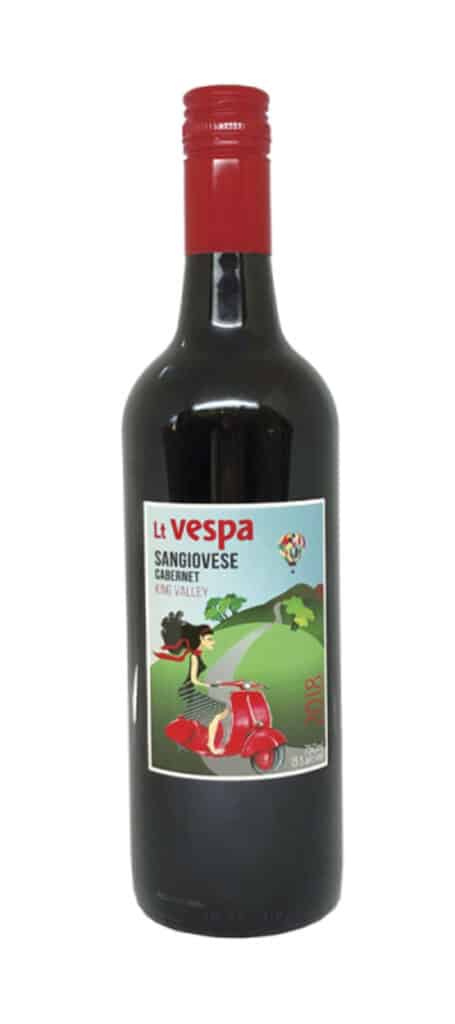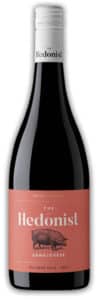WINE
SANGIOVESE Move over, Italy…our Sangio is a stunner!

WORDS: @peterpanwine. PHOTOGRAPHY Supplied
My first experience with Sangiovese was dining in old old-fashioned but traditional Italian restaurant: you know the one, dimly lit, with red-checked tablecloths, the obligatory mural of a gondola in Venice on the wall, romantic accordion music playing in the background, oh and the wicker covered bottle with the melted candle burning in the centre of the table. Yeah, that one! Turns out the wine once in that bottle was Chianti a wine made from Sangiovese grapes.
What is Sangiovese?
Sangiovese (SAN-jo-vay-zay) is Italy’s most widely planted grape variety and is considered the workhorse of the Italian wine industry. The name Sangiovese is derived from Latin meaning “the blood of Jove” which refers to the Roman God Jupiter, thus fuelling theories the variety may have been around since ancient Roman times. However, according to a data sheet from Chalmers, one of the leading nurseries for propagating alternative grape varieties in Australia, “it is difficult to find the history of this variety before the sixteenth century, when it was described in a document on Tuscan viticulture. It is generally thought of as being native to Tuscany but geneticists have discovered that Sangiovese comes from an old Tuscan variety crossed with a Calabrian variety”.
Specifically, Sangiovese is a somewhat thin-skinned grape not unlike Pinot Noir but it may develop thicker skin in warmer climates and with clonal differences. As Jancis Robinson states in her Oxford Wine Companion book “Sangiovese’s dominant viticultural characteristics are that it can vary as much as Pinot Noir in its sensitivity to place and that it ripens relatively late. This means that if it is planted too high in Tuscany it can all too easily produce wine that is tart and unripe. “
Further, Sangiovese is a late and slow ripening variety that is a robust and resistant grape but is prone to high yields if not managed correctly. Specifically, the Young Guns of Wine website states “Ripening relatively late, Sangiovese can produce lean and green fruit in more marginal climates, but it is also in many of Tuscany’s cooler vineyards that it produces the best expressions. In warmer zones, it can become broad and lose definition, or just be a little simple. It also has a natural tendency to produce high yields, so quality-minded producers will always seek to limit vigour.”
Interestingly, Sangiovese berries are medium in size, oval-shaped blue-black and or purple in colour. Many of the clonal types including “piccolo” have very small berries with some berries being seedless. Characteristics of the bunch are quite large, cylindrical-pyramidal in shape, compact and generally with a wing. The peduncle (the stalk bearing the fruit) is large and visible, and semi-woody. Clusters are medium; wide and long conical, and well-filled. The grape produces medium-bodied wine, with both high acidity and high tannins.’’
As a wine, Sangiovese is of medium body, with acidity and intense tannins making a super food-friendly wine, while the colour in the glass is ruby. Sangiovese has notes of cherry, dried berries, dried earth, tomato leaves, cedar and leather although these characteristics will differ with cooler and warmer climate regions and with early or later picked fruit. Further, Sangiovese is a wine with an extraordinary aging power, particularly suitable for aging in large barrels but may not receive any oak treatment at all. In Italy, Sangiovese may often be blended with small amounts of local grapes for Chianti, such as Canaiolo and Colorino, as well as Cabernet Sauvignon and Merlot.
Where does Sangiovese grow best?
While Sangiovese is found worldwide, arguably the best of the variety is found in Italy with over 100,000 hectares planted. According to the Young Guns of Wine site, “Sangiovese is the most prevalent variety in four of Italy’s 20 regions, and it is a significant player in nine others. It is the majority component of 100 DOC/DOCGs (appellations) and nearly as many IGPs while contributing in a lesser way to countless more. Perhaps most importantly, Sangiovese is also responsible for some of Italy’s greatest and most famous wines such as Chianti, Brunello di Montalcino, and Vino Nobile di Montepulciano – all of which happen to be located in Tuscany. Sangiovese was also the backbone of the Super Tuscan wines that shook up the establishment in the 1980s and 90s, marking a new era for Italian wine internationally.” For example, many Super Tuscan reds include or rely on Sangiovese, such as Tignanello, a wine made with Sangiovese and then blended with Cabernet Sauvignon and Cabernet Franc, whereas Solaia reverses that, leaning primarily on Cabernet Sauvignon that’s supplemented with Cabernet Franc and Sangiovese. Interestingly, not all Super-Tuscans employ Sangiovese like Macchiole which focuses entirely on Cabernet Sauvignon, Cabernet Franc, Merlot, and Syrah for their mono-varietal reds; and Ornellaia doesn’t use it at all in their blends. Sangiovese plantings can also be found outside central Italy (Tuscany) including Lombardia, Emilia-Romagna, Valpolicella and as far south as Campania and Sicily. Also, plantings can be found in Lazio, Umbria, and Marche (all of which border Tuscany).
Jancis Robinson states Sangiovese has shown itself to be adaptable to many different types of vineyard soils but seems to thrive in soils with a high concentration of limestone, having the potential to produce elegant wines with forceful aromas.
Outside of Italy, Sangiovese is also flourishing in Corsica where the variety is known as Nielluccio or Niellucciu and has a distinctive maquis characteristic, which distinguishes it somewhat from other Sangiovese varieties. However, it is not a particularly strong variety outside the homeland despite the USA growing the grape since the 1900s, a legacy of Italian immigrants leading the charge, especially into California. Also, small plantings can be found in Canada, Argentina, Brazil, Chile and even Mexico as well as South Africa and New Zealand.
Here in Australia, the variety was introduced in the 1960s to the CSIRO but it was not until the late 1970s that Penfolds planted it in the Barossa Valley, South Australia, and Montrose focussing their efforts on Mudgee in New South Wales. A few years later and according to the Young Guns of Wine site, it was not until 1985 “that Mark Lloyd of McLaren Vale’s Coriole planted the variety and seriously captured the public’s imagination, with Coriole still one of the leading players. Better clones are used nowadays so examples were on the lighter side”. Today, Sangiovese grows particularly well in the cooler climates of the King Valley, Orange, Stanthorpe and the warm region of Heathcote.
Why Sangiovese?
Sangiovese has been growing in Australia for well over 50 years now and with the introduction of new clones, our wines have improved for the better including the wines from Italy. The availability of good quality imported Italian Sangiovese and locally made wine has never been better and must be on the shopping list.
The variety suits our climate, lifestyle and our foods. Like many other varieties, Sangiovese is particularly suited to Australia’s vast dry regions and can be made in a manner of styles and blends that are both well-priced and ultra-premium, thus suiting the experienced and the well-to-do experienced drinker as well. Australia’s love affair with Mediterranean food is an ideal match for Sangiovese and all its guises. With its high acidity and tannins Sangiovese is particularly suited to both classic Italian and tomato-based dishes. Tomatoes, herbs and red meats all work well with Sangiovese. It can balance, enhance or harmoniously accompany a huge range of dishes, from pasta, pizza, roast chicken, charcuterie, moussaka, sausage, grilled and smoked meats and more.
Sangiovese provides an ideal and surprisingly good alternative to our more traditional varieties. Australia is ready to put Sangiovese on the table!
What to Consider
Il Palazzo Chianti DOCG is estate grown on over 35 hectares and the property stands on a high hill 300-400 metres above sea level. In the centre of the property is a farmhouse, a medieval hamlet with a swimming pool, all surrounded by vineyards, 6,000 olive trees, woods and arable land. The Il Palazzo winery lies a few kilometres from Arezzo in the heart of Tuscany and has around 100 years of history. The estate soils are made of clay, sand, limestone, the typical Chianti stone Galestro. The winery is quite modern and features the use of stainless steel and French oak barrel treatment. This wine has won a silver medal at the Decanter World Wine Awards and a bronze medal at the International Wine & Spirit Competition amongst others. The colour is ruby red with notes of cherry and rose petals. It is made of 90% Sangiovese and is matured in stainless steel barrels. The palate is rich and juicy of medium weight with silky fine tannins. Try this wine with red meats roasted or BBQ, but I would certainly enjoy it with pasta or pizza.
Next try, Little Vespa Sangiovese. The wine hails from the cool climate region of King Valley in Victoria and is made by an Italian family with roots going back to the 1950s. The King Valley is located in the northern eastern part of Victoria not far away from the Alpine Valley and Beechworth. The King Valley is elevated which is around 200 – 300 metres above sea level. The soils vary but are mostly a deep red clay loam. The King Valley can be described as a little piece of Italy set amongst the hills of Northeast Victoria. The region was once used by Italian immigrants for tobacco before they were transformed into award-winning wineries, festivals and great local produce. The word Vespa means Wasp and they can be seen buzzing around the cellar during vintage. It is also the name of the famous motor scooter created just after World War II and featured on the wine label. This is a fun wine easy to drink but made well with good quality fruit. The colour is a deep red and the nose exhibits aromas of dark cherries, bay leaf and sweet pancetta. On the palate there are flavours of cherries, sun-dried tomatoes, liquorice and the tannins are lingering with a savoury finish. The wine is matured in oak for ten months and will pair well with tomato-based dishes but is truly awesome with pizza and pasta too.
From McLaren Vale, South Australia try the Hedonist Sangiovese. Hedonist Vineyards were established in 1982 and the winery is 4.5 stars rated by James Halliday and is certified biodynamic and organic. The wines are made by husband and wife team James and Kimberley Cooter from Cooter and Cooter Wines and the legendary Walter Clappis (father of Kimberley), a veteran winemaker for over 30 years. Walter was the owner and winemaker of Ingolby wines and has been awarded the highly prized Bushing King award for the highest-scoring individual wine at the McLaren Vale wine show. Their Hedonist Sangiovese is ruby red in colour with notes of cherry, paprika and cinnamon on both the nose and palate. The wine is medium weight, savoury with fine powdery tannins and spends 8 months in 300-litre seasoned French oak barrels. James Halliday has awarded this wine 94 points and it’s a must to pair with gnocchi fried in butter or with creamy mushroom sauces, thick cuts of pork, spaghetti Bolognese or as simple as prosciutto, cheese and salami.
Enjoy and happy but safe drinking. You can catch Peter on Facebook, Twitter & Instagram as @peterpanwine.












